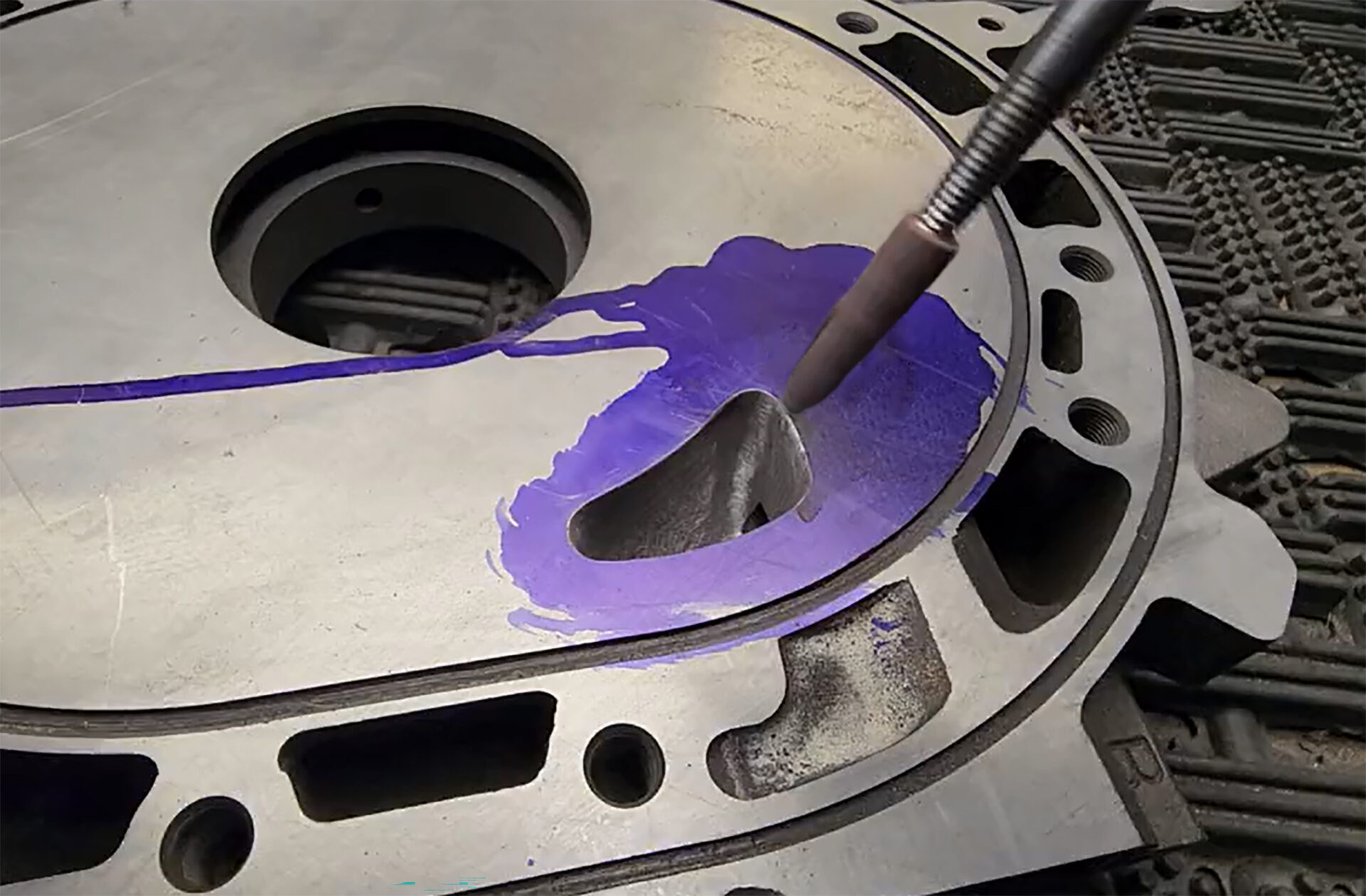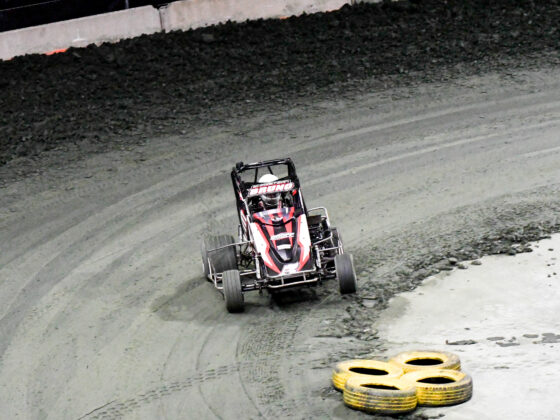 The 13B REW engine features two different size ports. A smaller primary port (left) that is located on each side of the center iron, and a larger secondary port (right) that resides on the front and rear iron of the 13B. Note the roughness of the port and how it does not match the port opening very well.
The 13B REW engine features two different size ports. A smaller primary port (left) that is located on each side of the center iron, and a larger secondary port (right) that resides on the front and rear iron of the 13B. Note the roughness of the port and how it does not match the port opening very well.
 On the block of the engine, the corresponding primary ports on the center iron are skinnier, while the outer secondary ports are larger on the front and rear iron and feed the larger secondary port opening inside the engine.
On the block of the engine, the corresponding primary ports on the center iron are skinnier, while the outer secondary ports are larger on the front and rear iron and feed the larger secondary port opening inside the engine.
There are a few main types of porting that is done to the rotary engine: Street Port, Bridgeport, and Peripheral Port.
 STREET PORTING
STREET PORTING
This is the most common and mild porting option that results in moderate performance gains with little to no compromises in gas mileage, drivability, or noticeably increased exhaust volume. Street ports generally feature a mild port cleanup with a small increase in size while staying “within the lines” of the oil and corner seal tracks. However, there is a pretty broad spectrum of variability from “Mild” to “Extended” and “Large/Aggressive” street ports.
Mild Street Ports typically clean up the port shape and open up the upper area of the port slightly to delay port closing and improve air flow and higher rpm gains. Extended Ports further extend the upper and lower area of the port, improving power at higher rpm. Aggressive Street Ports increase the port size further while advancing the port timing which greatly increases power in the midrange and spools turbos much quicker. This also increases overlap between the intake and exhaust, and any time you increase this overlap, low RPM performance and idle quality suffers and requires a slightly higher idle. Sub 1,000rpm idles can still be achieved with most street porting.
“Race-Port” is what some engine builders call an even more extreme street-style port with more overlap and drivability issues.
 BRIDGE PORTING
BRIDGE PORTING
Bridge porting increases airflow into the combustion chamber by cutting a thin slit or “eyebrow” above the main port while leaving a strip or “bridge” to support the rotor’s corner seal as it passes over the port.
This is considered the first stage of “race porting” and provides massive gains in high RPM airflow and power. As overlap increases from more aggressive bridge porting, idle quality quickly suffers and the infamous “brap, brap, brap” exhaust note becomes more pronounced. Because of this, the idle rpm must be increased to prevent the engine from dying, low rpm response and performance starts to suffer, and the exhaust volume becomes noticeably louder.
 Bridge porting falls into two main categories: Half-bridge and Full-bridge. Half-bridge Port adds the additional “eyebrow” ports only to the outer secondary intake ports in the rotary’s side housing/iron, while the primary ports on the center iron is just street ported. This somewhat gives you the best of both worlds by minimally affecting the low rpm performance and improving high rpm airflow.
Bridge porting falls into two main categories: Half-bridge and Full-bridge. Half-bridge Port adds the additional “eyebrow” ports only to the outer secondary intake ports in the rotary’s side housing/iron, while the primary ports on the center iron is just street ported. This somewhat gives you the best of both worlds by minimally affecting the low rpm performance and improving high rpm airflow.
Full-Bridge Porting adds “eyebrow” ports above both the primary and secondary intake ports, greatly improving high rpm flow. This is popular on naturally aspirated rotaries, which tend to use very long Bridgeports that significantly advances the port timing and overlap, produce more high RPM power, but are often only recommended for race cars due to their compromises like requiring much higher idle RPMs and worse low-rpm performance.




20 comments
Great article and build. As a non-rotary guy, I haven’t seen any extreme power builds that are quiet. I would love to see a 4 rotor/3 rotor big build or even a 250hp NA build but actually be OEM quiet. Is it possible??
Thank you. We are shooting for over 600whp with this build while being as quiet and streetable as possible. We are going to use the largest mufflers currently on the market so stay tuned to see how quiet the setup will be.
Part of why a rotary is so loud is that there is no poppet valve to should the port so there is a lot stronger exhaust pulse coming out of the port.
ahhh that makes a lot of sense. cant wait for the rest of the build, especially the quiet part
The exhaust port also opens much quicker than a cam controlled exhaust port.
Fantastic article. I think I finally (sort of) understand all the different rotary porting types that I have read about for decades now. This engine is going to be killer!
In my opinion one of the best rotary tech references out there period.
Why wouldn’t you radius the edges of the port to enhance flow? Seems like a no-brainer to me.
Probably to avoid snagging a seal
I the young age of 14 in 1974 when USAC was using Ported Rotory engines for Competition use in their Sprint Cars .
As far as I know , I was one of VERY FEW duing this .
They were DEVASTATINGLY FAST & HAD A WORKING POWERBAND OF 7000-12000+ R.P.M.s .
The n they Outlawed them like they did with the 426 “HEMI”s
Some body talk!!! In PR we use that in the 80 and 90! En Puerto Rico nosotros usamos eso desde Los anos 1980, cuando Los motors con mas caballaje empezaron a romper Los housing en El area del pase del aceite Denison a la torcion del motor y tambien dependia de donde estaba agarrado El motor, Esto es para Los que trabajar I motors desde Los anos 1980! Pero tambien Les haciamos Algo a Los rotors que yo nunca e visto a nadie comentar!!! Que Tenga buen dia!
Translation:
“In Puerto Rico we used that since the 1980s, when the engines with more horsepower began to break the housing in the area of the Denison oil pass to the engine torque and also depended on where the engine was caught, this is for those who work I motors since the 1980s! But we also did Something to The Rotors that I’ve never seen anyone comment on!!! Have a good day!”
What did you do in the 80s and 90s? Porting?
What did you do to the rotors that you have not seen
Yes, the rear iron can crack resulting in a disastrous oil pressure loss and oil spraying all over the engine bay. There are some tricks to prevent this issue.
What did you do to the rotors that no one has commented on?
Thanks for the comment.
I had many talks involving regard’s too what port I wanted to use. No one explained it as well as this article. Half Bridge it is, I didn’t want to compromise on the lower RPM range whist still having a Brap
I’m glad to hear the article helped your understanding of different bridge ports. Just keep in mind the major takeaway of porting can vary greatly depending on who is doing the work. You can have an aggressive street port with worse low rpm performance than a mild, full bridge port. A half bridge probably be a good idea for your goals and would safeguard a little against a bad port job, but it’s worth it to have an experienced person do the porting.
The rotary engine is a breakthrough in engineering which was destroyed by pollution devices mandated by politicians normally aspirated engines are light and powerful and will last much longer then most high performance piston engines I still daily drive my 1988 RX7 which I streetported myself and enjoy the smooth idle and tork throughout the power band. This engine got a bad deal. And yes I get great mileag.
The Rotary Engine is a very unique engine
Seems like if you had some way to independently throttle an added peripheral port, you could get the best of both port styles. Has this been attempted?
Really excited to see this build evolve & article series, you’ve got a great team behind this build,
I was wondering if you considered other modern alternative to filling block water jacket for Periph. Port, people have had issues with epoxies, but is this due to incorrect choice of epoxy, prep., execution, etc.?
Here’s some info on alternatives
https://m.youtube.com/watch?v=Z9FBcSZruP8
https://m.youtube.com/watch?v=pnSdMd4XXzQ
https://m.youtube.com/watch?v=lRjCuvLCEbo
https://m.youtube.com/watch?v=SkTHNRqZDKc
https://m.youtube.com/watch?v=egU7I3V_Gv4
This is a awesome! Thanks for your guys for posting this. When I do my build I will fallow this one. I did work with CTP and WPC with the info from you guys on another project.
Hi Mike,
How much does the cryo treatment run for the rotating assembly and housings, if you don’t mind me asking? I’ve worked out a breakdown for WPC treatment costs, but didn’t consider the benefits of cryogenics.
Also, I know Turblown makes a great upper & lower intake manifold with semi P-ports for the REW, but one thing I always wondered was: what if the ports were staged, kind of what Mazda did with the Renesis 6-port? Primaries always open, secondaries opening at say 4500-ish rpm, semi p-port opening at 6000-ish rpm. Staging either with slide throttles or double roller barrel throttles ($$$ though). This would keep near stock low-rpm idle quality and drivability, while progressively extending the torque and power curves. What do you think, worth it or too complex for the gains?
I should probably ask Turblown about this, but if intake port staging is not worth it, would a tappered semi p-port runner help increase air velocity and fuel atomization at low rpm (without choking at high rpm)? And what if the primary fuel injectors were those in the semi p-ports, would that gain any type of stratified charge effect (which was experimented on in the early developpment days of the Wankel)?
Finally, I ate up the whole hour long video you did with Rob Dahm. Lots of useful information there.
There are so many ideas I would like to tinker around and test, but unfortunately I don’t have Rob’s budget haha!
Keep these articles coming!